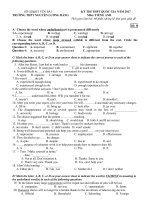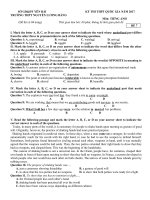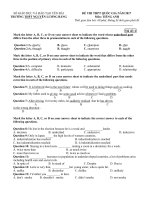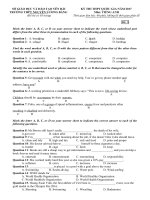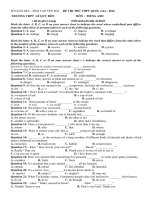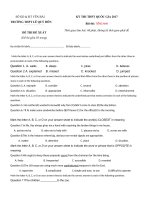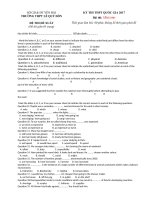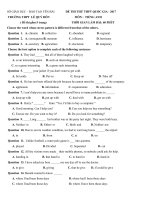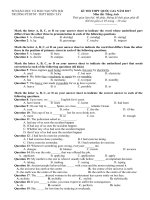501 câu hỏi ngữ pháp và bài tập viết Tiếng Anh
Bạn đang xem bản rút gọn của tài liệu. Xem và tải ngay bản đầy đủ của tài liệu tại đây (663.89 KB, 154 trang )
501 GRAMMAR
AND WRITING
QUESTIONS501 GRAMMAR
AND WRITING
QUESTIONS
NEW YORK
3rd Edition
®
Copyright © 2006 LearningExpress, LLC.
All rights reserved under International and Pan-American Copyright Conventions.
Published in the United States by LearningExpress, LLC, New York.
Library of Congress Cataloging-in-Publication Data
501 grammar & writing questions.—3rd ed.
p. cm.
ISBN 1-57685-539-2
1. English language—Grammar—Examinations, questions, etc. 2. English language—
Rhetoric—Examinations, questions, etc. 3. Report writing—Examinations, questions,
etc. I. Title: 501 grammar and writing questions. II. Title: Five hundred one grammar
and writing questions. III. Title: Five hundred and one grammar and writing questions.
PE1112.A15 2006
428.2'076—dc22
2005035266
Printed in the United States of America
9 8 7 6 5 4 3 2 1
Third Edition
ISBN 1-57685-539-2
For more information or to place an order, contact LearningExpress at:
55 Broadway
8th Floor
New York, NY 10006
Or visit us at:
www.learnatest.com
INTRODUCTION vii
SECTION 1 Mechanics: Capitalization and Punctuation 1
SECTION 2 Sentence Structure 11
SECTION 3 Agreement 29
SECTION 4 Modifiers 43
SECTION 5 Paragraph Development 49
SECTION 6 Essay Questions 95
ANSWERS 103
Contents
v
his book—which can be used alone, along with another writing-skills text of your choice, or in com-
bination with the LearningExpress publication, Writing Skills Success in 20 Minutes a Day—will give
you practice dealing with capitalization, punctuation, basic grammar, sentence structure, organiza-
tion, paragraph development, and essay writing. It is designed to be used by individuals working on their own and
for teachers or tutors helping students learn or review basic writing skills. Additionally, practicing with 501 Gram-
mar and Writing Questions will greatly alleviate writing anxiety.
Many people grimace when faced with grammar exercises. But in order to communicate with others, pass
tests, and get your point across in writing, using words and punctuation effectively is a necessary skill. Maybe you’re
one of the millions of people who, as a student in elementary or high school, found memorizing grammar rules
tedious. Maybe you were confused by all of the exceptions to those rules. Maybe you thought they would just come
naturally as you continued to write and speak.
First, know you are not alone. It is true that some people work very hard to understand the rules, while oth-
ers seem to have a natural gift for writing. And that’s okay; we all have unique talents. Still, it’s a fact that most
jobs today require good communication skills, including writing. The good news is that grammar and writing skills
can be developed with practice.
Introduction
vii
Learn by doing. It’s an old lesson, tried and true.
The 501 grammar and writing questions included in
these pages are designed to provide you with lots of
practice. As you work through each set of questions,
you’ll be gaining a solid understanding of basic gram-
mar and usage rules. And all without memorizing!
This book will help you improve your language skills
through encouragement, not frustration.
An Overview
501 Grammar and Writing Questions is divided into
six sections:
Section 1: Mechanics: Capitalization and
Punctuation
Section 2: Sentence Structure
Section 3: Agreement
Section 4: Modifiers
Section 5: Paragraph Development
Section 6: Essay Questions
Each section is subdivided into short sets con-
sisting of 8–20 questions.
The book is specifically organized to help you
build confidence as you further develop your written-
language skills. 501 Grammar and Writing Questions
begins with the basic mechanics of capitalization
and punctuation, and then moves on to grammar and
sentence structure. By the time you reach the section
on paragraph development, you’ve already practiced on
almost 300 questions. You will then continue practic-
ing the skills you’ve already begun to master in the
previous four sections, this time, in combination.
When you get to the last section, you’ll be ready to
write your own essays.
How to Use This Book
Whether you’re working alone or helping someone
brush up on grammar and usage, this book will give
you the opportunity to practice, practice, practice.
Working on Your Own
If you are working alone to review the basics or prepare
for a test in connection with a job or school, you will
probably want to use this book in combination with a
basic grammar and usage text, or with Writing Skills
Success in 20 Minutes a Day. If you’re fairly sure of your
basic language-mechanics skills, however, you can use
501 Grammar and Writing Questions by itself.
Use the answer key at the end of the book not only
to find out if you chose the right answer, but also to
learn how to tackle similar kinds of questions next
time. Every answer is explained. Make sure you under-
stand the explanations—usually by going back to the
questions—before moving on to the next set.
Tutoring Others
This book will work well in combination with almost
any basic grammar and usage text. You will probably
find it most helpful to give students a brief lesson in the
particular skill they’ll be learning—capitalization,
punctuation, subject-verb agreement, pronoun agree-
ment, sentence structure, style—and then have them
spend the remainder of the session answering the ques-
tions in the sets. You will want to impress upon them
the importance of learning by doing, checking their
answers, and reading the explanations carefully. Make
sure they understand a particular set of questions
before you assign the next one.
– INTRODUCTION–
viii
Additional Resources
For more detailed explanations of English grammar
and usage rules, you may want to buy—or borrow
from the library—one or more of the following books:
Action Grammar: Fast, No-Hassle Answers on Everyday
Usage and Punctuation by Joanne Feierman (Fireside)
The American Heritage Book of English Usage: A Prac-
tical and Authoritative Guide to Contemporary English
(Houghton Mifflin)
The Blue Book of Grammar and Punctuation: The Mys-
teries of Grammar and Punctuation Revealed by Jane
Straus (Jane Straus Books)
Grammar Smart: A Guide to Perfect Usage, 2nd Edition
(Princeton Review)
Grammatically Correct: The Writer’s Essential Guide to
Punctuation, Spelling, Style, Usage and Grammar by
Anne Stilman (Writers Digest Books)
The Oxford Dictionary of American Usage and Style by
Bryan A. Garner (Berkley Publishing Group)
Quick Review Writing: Grammar, Usage, and Style by
Jean Eggenschwiler and Emily Dotson Biggs (Cliffs
Notes)
Woe is I: The Grammarphobes Guide to Better English in
Plain English, 2nd Edition, by Patricia T. O’Conner
(Riverhead Books)
Writing Skills Success in 20 Minutes a Day, 3rd Edition
(LearningExpress)
Writing Smart: Your Guide to Great Writing, 2nd Edi-
tion, by Marcia Lerner (Princeton Review)
– INTRODUCTION–
ix
AND WRITING
QUESTIONS
ince every sentence begins with a capital, the how-to’s of capitalization seem like a logical place to
begin learning about language mechanics. When doing the exercises in this section, refer to the
following checklist. Matching your answer to a rule will reinforce the mechanics of writing and
secure that knowledge for you.
Capitalization Checklist
✓ The first word of every sentence➞Yes, we do carry the matching bed skirt.
✓ The first word of a quoted sentence (not just a quoted phrase)➞And with great flourish, he sang, “O beautiful
for gracious skies, for amber waves of grain!”
✓ The specific name of a person (and his or her title), a place, or a thing (otherwise known as proper nouns). Proper
nouns include specific locations and geographic regions; political, social, and athletic organizations and agen-
cies; historical events; documents and periodicals; nationalities and their language; religions, their members
and their deities; brand or trade names; and holidays.
✓ The abbreviation for proper nouns. Government agencies are probably the most frequently abbreviated.
Remember to capitalize each letter.➞The CIA makes me feel very secure.
✓ Adjectives (descriptive words) derived from proper nouns.
Ex: America (proper noun)➞the American (adjective) flag
✓ The pronoun I.
✓ The most important words in a title➞Last March, I endured a twenty-hour public reading of ATale of Two Cities.
SECTION
Mechanics:
Capitalization and
Punctuation
1
1
Punctuation Checklist
Periods
✓ At the end of a declarative sentence (sentence that
makes a statement)➞Today, I took a walk to
nowhere.
✓ At the end of a command or request➞Here’s a cloth.
Now gently burp the baby on your shoulder.
✓ At the end of an indirect question➞Jane asked if I
knew where she had left her keys.
✓ Before a decimal number➞Statisticians claim that
the average family raises 2.5 children.
✓ Between dollars and cents➞I remember when $1.50
could buy the coolest stuff.
✓ After an initial in a person’s name➞You are Sir
James W. Dewault, are you not?
✓ After an abbreviation➞On Jan. 12, I leave for Africa.
Question Marks
✓ At the end of a question➞Why do you look so sad?
✓ Inside a quotation mark when the quote is a ques-
tion➞She asked, “Why do you look so sad?”
Exclamation Points
✓ At the end of a word, phrase, or sentence filled with
emotion➞Hurry up! I cannot be late for the meeting!
✓ Inside a quotation mark when the quote is an excla-
mation➞The woman yelled, “Hurry up! I cannot be
late for the meeting!”
Quotation Marks
✓ When directly quoting dialogue, not when para-
phrasing➞Hamlet says, “To be, or not to be. That is
the question.”
✓ For titles of chapters, articles, short stories, poems,
songs, or periodicals➞My favorite poem is “The
Road Not Taken.”
Semicolons
✓ Between two independent clauses (an independ-
ent clause is a complete thought. It has a subject and
a predicate.)➞Edward joined the basketball team;
remarkably, the 5´4˝ young man excelled at the sport.
✓ Between elements in a series that uses commas
➞The possible dates for the potluck dinner are Thurs-
day, June 5; Saturday, June 7; or Monday, June 9.
Colons
✓ Between two complete ideas when the second idea
explains the first.➞Keri pushed her dinner away:
She had eaten on the car ride home.
✓ Before a list➞Grandma brought Chloe’s favorite
three sweets: chocolate kisses, Tootsie Rolls, and a
Snickers bar.
✓ Between titles and subtitles➞Finding Your Dream
Home: A Buyer’s Guide.
✓ Between volumes and page numbers➞Marvel
Comics 21:24
✓ Between chapters and verse➞Job 4:12
✓ Between hours and minutes➞It’s 2:00 a.m.—time
to sleep.
Apostrophes
✓ Where letters or numbers have been deleted—as in
a contraction➞I looked at my father and whispered,
“It’s (It is) okay to cry every so often.”
✓ At the end of a name where there is ownership
(remember to also add an s after the apostrophe if
the word or name does not end in an s already)
➞Mary Jane’s horse sprained his ankle during
practice.
– MECHANICS: CAPITALIZATION AND PUNCTUATION–
2
Commas
✓ Between items in dates and addresses➞Michael
arrived at Ellis Island, New York, on February 14,
1924.
✓ Between words in a list➞The university hired a
woman to direct the Bursar’s, Financial Aid, and Reg-
istrar’s offices.
✓ Between equally important adjectives (be care-
ful not to separate adjectives that describe each
other)➞The reporter spoke with several intense, tal-
ented high school athletes.
✓ After a tag that precedes a direct quote➞David
whined, “I am famished.”
✓ In a quote that precedes a tag and is not a question
or an exclamation➞“I am famished,” whined David.
✓ Around nonessential clauses, parenthetical phrases,
and appositives (A nonessential or nonrestrictive
clause is a word or group of words that are not nec-
essary for the sentence’s completion; a parentheti-
cal phrase interrupts the flow of a sentence; and an
appositive is a word or group of words that rename
the noun preceding them)➞Matt’s mother, Janie
(appositive), who has trouble with directions (non-
essential clause), had to ask for help.
✓ After introductory words, phrases, and clauses➞
Hoping for the best, we checked our luggage.
✓ Before conjunctions (Conjunctions are words that
link two independent clauses together)➞Drew
wanted to experience ballroom dancing before his
wedding, so he signed up for lessons at a local hall.
––MECHANICS: CAPITALIZATION AND PUNCTUATION––
3
SET 1 (Answers begin on page 103.)
For the following questions, choose the lettered part of the sentence that contains a word that needs a capital
letter. If no additional words should be capitalized, choose answer e. Refer to the checklist at the beginning of
the chapter if you want to be certain about your answer.
1. Last week, | dr. Tanya Miller received | a special award from the | city of Atlanta. | None
ab c de
2. The new bakery | in the center of town | sells a wide assortment | of italian pastries. |None
ab c de
3. Michael Blake, jr., | is such an accomplished golfer | that he won three tournaments | in a row. | None
ab cde
4. Catherine complained loudly, | “why can’t you ever | pick me up on time | in the morning?” | None
a b c d e
5. The Declaration of Independence | is one of the most important | documents in the history |
abc
of the United States. | None
de
6. Sally’s Sweet shop, | one of the oldest businesses in town, | is located on one of the main streets |
ab c
of Millersville. | None
de
SET 2 (Answers begin on page 103.)
Choose the punctuation mark that is needed in each
of the following sentences. If no additional punctuation
is needed, choose answer e.
9. “It isn’t fair!” shouted Martin. Coach Lewis
never lets me start the game!”
a. .
b. ,
c. !
d. “
e. none
10. Maureen’s three sisters, Molly, Shannon, and
Patricia are all spending the summer at their
grandmother’s beach house.
a. ;
b. –
c. !
d. ,
e. none
11. For the centerpieces, the florist recommended
the following flowers daisies, tulips, daffodils,
and hyacinths.
a. :
b. ,
c. .
d. ;
e. none
12. Lily is an accomplished gymnast she won three
medals in her last competition.
a. ;
b. ,
c. ?
d. :
e. None
13. Everyone was shocked when Max Smithfield—
a studious, extremely bright high school senior
decided that college was not for him.
a. ;
b. ,
c. –
d. :
e. none
14. Kims assistant, usually so reliable, has been late
for work three times this week, without any
excuse.
a. ’
b. ,
c. ;
d. .
e. none
15. Before sending out invitations, Margo checked
the party date with her mother-in-law.
a. ,
b. ;
c. –
d. .
e. none
––MECHANICS: CAPITALIZATION AND PUNCTUATION––
4
7. My first childhood pet, | a gray cat named otis, | was given to me as a gift | on my fifth birthday. | None
ab cde
8. The local elementary school | is organizing a screening | of the movie toy story |as a fundraiser. | None
abcde
16. “I remember” Luis recollected, “the first time I
was allowed to walk home from school by
myself.”
a. ?
b. ,
c. :
d. ;
e. none
17. Madeline Larkin our office manager, is the
most organized person I’ve ever known.
a. :
b. ;
c. –
d. ,
e. none
18. I spend most of my time at the gym on the
treadmill walking is my favorite form of
exercise.
a. ,
b. ?
c. ;
d. !
e. none
SET 3 (Answers begin on page 104.)
Choose the answer that shows the best punctuation
for the underlined part of the sentence. If the sentence
is correct as is, choose e.
19. Simone bought three new pairs of shoes even
though she had put herself on a tight budget
just last week.
a. shoes, even though, she
b. shoes, even though she
c. shoes. Even though she
d. shoes; even though she
e. correct as is
20. Most residents of the building have air
conditioners however I’ve always found that a
ceiling fan is sufficient.
a. air conditioners however: I’ve
b. air conditioners, however, I’ve
c. air conditioners however, I’ve
d. air conditioners; however, I’ve
e. correct as is
21. “Are you OK,
” aske
d Timothy, “Ar
e you sure
you don’t want to sit down and rest for a
while?”
a. OK?” asked Timothy. “Are
b. OK?” asked Timothy, “Are
c. OK,” asked Timothy? “Are
d. OK?” asked Timothy? “Are
e. correct as is
22. The owners of the restaurant maintain that
only organic ingredients are used in their
kitchen.
a. maintain, that only
b. maintain that, only
c. maintain: that only
d. maintain—that only
e. correct as is
23. Before the student could be hired by the
c
ompany, the students adviser had to provide a
letter of recommendation.
a. company the students
b. company, the student’s
c. company, the students’
d. company the students’
e. correct as is
––MECHANICS: CAPITALIZATION AND PUNCTUATION––
5
24. The volunteers who would like to work the
morning shift
should sign their name on this
sheet.
a. volunteers, who would like to work the
morning shift
b. volunteers who would like to work the
morning shift,
c. volunteers, who would like to work the
morning shift,
d. volunteers who, would like to work the
morning shift,
e. correct as is
25. The employees asked whether the company
would be offering tuition r
eimbursement
within the next three years?
a. reimbursement within the next three years!
b. reimbursement, within the next three years.
c. reimbursement within the next three years.
d. reimbursement, within the next three years?
e. correct as is
26. This is the new restaurant you’ve been talking
ab
out, isn’t it?
a. about isn’t it?
b. about, is’nt it?
c. about, isn’t it.
d. about isn’t it.
e. correct as is
27. T
urnips a root vegetable can be mashed,
roasted, or used in casseroles.
a. Turnips, a root vegetable,
b. Turnips, a root vegetable
c. Turnips, a root vegetable—
d. Turnips a root vegetable,
e. correct as is
28. They met for the first time on A
ugust 27, 1972
in Seattle, Washington.
a. August 27 1972 in Seattle, Washington.
b. August 27 1972, in Seattle Washington.
c. August 27, 1972 in Seattle, Washington.
d. August 27, 1972, in Seattle, Washington.
e. correct as is
SET 4 (Answers begin on page 104.)
For each question, find the sentence that has a mis-
take in capitalization or punctuation. If you find no
mistakes, mark choice d.
29. a. My least favorite season is Winter.
b. Next Friday, Uncle Jake is coming to visit.
c. Maureen served as treasurer for the
women’s organization.
d. No mistakes.
30. a. “Can you attend next week’s meeting?” she
asked.
b. His new car was damaged in the accident.
c. The girls’ giggled through the whole movie.
d. No mistakes.
31. a. Leo told her, to call the customer service
department in the morning.
b. She put up signs all over town, but she
didn’t get any response.
c. Occasionally, her neighbors ask her to feed
their cat.
d. No mistakes.
32. a. Did you see the movie Shrek?
b. She was given an award by mayor Chambers.
c. Math and science are my two best subjects.
d. No mistakes.
––MECHANICS: CAPITALIZATION AND PUNCTUATION––
6
33. a. A major highway is being built on the
outskirts of town.
b. When you reach the traffic light on
Berkshire Road, turn right onto Springfield
Blvd.
c. We were staying at my sister’s cape Cod
vacation home.
d. No mistakes.
34. a. The instructor asked us if we needed more
time?
b. Carla’s mother is a pediatric dentist.
c. Every item in the store costs less than a
dollar.
d. No mistakes.
35. a. Jane’s family owned three Persian cats.
b. My Uncle always takes the subway to Yankee
Stadium.
c. Everyone knows that Marisa’s favorite book
is Pride and Prejudice.
d. No mistakes
36. a. “I’ll do the grocery shopping for you,
grandma,” Lucy said.
b. “Where can I find the best pizza in town?”
he asked.
c. “Be sure to arrive two hours early,” she
warned.
d. No mistakes.
37. a. I always have a hard time getting up in the
morning.
b. We took: a tent, a cooler, and a sleeping bag.
c. The fog was as thick as potato soup.
d. No mistakes.
38. a. This is someone elses coat.
b. Which of these songs was recorded by Bruce
Springsteen?
c. That book must be yours.
d. No mistakes.
39. a. Don’t stand in my way.
b. Cecilia and I fought our way through the
crowd.
c. The vegetables were old rubbery and
tasteless.
d. No mistakes.
40. a. Remember to walk the dog.
b. “Don’t run”! Mr. Ellington shouted.
c. It’s supposed to snow today and tomorrow.
d. No mistakes.
41. a. Charleen’s parents worried whenever she
drove the car.
b. Who designed the Brooklyn Bridge?
c. Diseases like Smallpox and Polio have been
eradicated.
d. No mistakes.
42. a. Can you find the Indian ocean on this map?
b.
Which river, the Nile or the Amazon, is
longer?
c. Lerner Avenue runs into the Thompson
Parkway.
d. No mistakes.
43. a. He’s the best dancer in the school.
b. We were planning to go, but the meeting
was canceled.
c. “Okay,” she said, I’ll go with you.”
d. No mistakes.
44. a. Does Judge Parker live on your street?
b. Twenty government officials met to deal
with Wednesday’s crisis.
c. The Mayor spoke at a news conference this
morning.
d. No mistakes.
––MECHANICS: CAPITALIZATION AND PUNCTUATION––
7
45. a. My brother, Isaac, is the best player on the
team.
b. Because of the high cost; we decided not to go.
c. Where’s your new puppy?
d. No mistakes.
46. a. I have learned to appreciate Mozart’s music.
b. My cousin Veronica is studying to be a
Veterinarian.
c. Mr. Shanahan is taller than Professor
Martin.
d. No mistakes.
47. a. “You look just like your mother,” Ms. Jones
told me.
b. “Please be careful,” he said.
c. Tyler asked, “why do I have to go to bed so
early?”
d. No mistakes.
48. a. Do you prefer root beer or orange soda?
b. In which year did world war II end?
c. I like to study the geography of the
Everglades.
d. No mistakes.
49. a. Colds like many other viruses are highly
contagious.
b. Call me when you feel better.
c. Did you wash your hands, Michael?
d. No mistakes.
50. a. The industrial revolution began in Europe.
b. Is Labor Day a national holiday?
c. General Patton was a four-star general.
d. No mistakes.
51. a. Carmen brought bread, and butter, and
strawberry jam.
b. Let’s look at the map.
c. Be sure to thank Aunt Helen for the gift.
d. No mistakes.
52. a. My Aunt Georgia loves to read Eighteenth-
Century novels.
b. Eli’s sister’s cousin lives in Alaska.
c. Is that a German shepherd?
d. No mistakes.
53. a.Those shoes are too expensive.
b. Michael’s best friend is Patrick.
c. Did you hear that Inez got a new puppy.
d. No mistakes.
SET 5 (Answers begin on page 105.)
Questions 54–57 are based on the following passage.
First, read the passage, and then choose the answer
that shows the best capitalization and punctuation
for each underlined part.
Madam Helena P. (54) B
lavatsky born in
Russia on May 8, 1831, claimed to have psy-
chic powers and to be capable of performing
feats of clairvoyance and telepathy. During
her sixty years, she traveled to many (55)
c
ountries—inc
luding the United States,
England, India, and Egypt, in order to study
the occult. Although many considered her a
(56) fak
e throug
hout her lifetime she was
surrounded by faithful believers, including
such influential persons as British states-
man Allen O. Hume and Swedish countess
Constance Wachtmeister. To this day, fol-
lowers commemorate the date of her (57)
d
eath calling May 8, “White Lotus Day.”
54. a. Blavatsky: born
b. Blavatsky—born
c. Blavatsky, born
d. Blavatsky. Born
e. correct as it is
––MECHANICS: CAPITALIZATION AND PUNCTUATION––
8
55. a. countries, including
b. countries: including
c. countries. Including
d. countries including
e. correct as it is
56. a. fake, throughout
b. fake. Throughout
c. fake: throughout
d. fake; throughout
e. correct as it is
57. a. death. Calling
b. death, calling
c. death: calling
d. death; calling
e. correct as it is
Questions 58–61 are based on the following passage.
First, read the passage, and then choose the answer
that shows the best capitalization and punctuation
for each underlined part.
June 2, 2006
Melanie Jeffords
312 Maple Avenue
Chicago, Illinois 60632
Mark (58) F
ranklin, general manager
Wholesome Food Market
1245 Main Street
Chicago, Illinois 60627
(59) d
ear Mr. Franklin;
I am writing to complain about the behav-
ior of one of your sales clerks. On (60) M
on-
day May 22nd I visited your store to return
a package of ground turkey that I had pur-
chased the day before. When I explained to
your sales clerk that the expiration date on
the package was May 1st, she was (61)
e
xtr
emely rud
e and she refused to refund
my money. This is not the kind of treatment
I expect from your fine establishment. I hope
you will make restitution and have a discus-
sion with your staff about customer service.
My receipt is enclosed.
Sincerely yours,
Melaine Jeffords
58. a. Franklin, general Manager
b. franklin, General Manager
c. Franklin, General Manager
d. Franklin, General manager
e. correct as it is
59. a. Dear Mr. Franklin.
b. Dear, Mr. franklin,
c. dear Mr. Franklin:
d. Dear Mr. Franklin:
e. correct as it is
60. a. Monday, May 22nd I
b. Monday May 22nd; I
c. Monday. May 22nd I
d. Monday, May 22nd, I
e. correct as it is
61. a. extremely rude, and she
b. extremely rude: and she
c. extremely rude? And she
d. extremely rude and, she
e. correct as it is
––MECHANICS: CAPITALIZATION AND PUNCTUATION––
9
sentence is like a Christmas present: Assembly is always required. Fortunately, the instructions are
fairly basic. Every sentence must have at least a subject and a predicate. The subject is the focus
of the sentence; it is the who or the what the sentence is about. The predicate describes the sub-
ject; it explains what the subject is or what the subject is doing. The completed idea is called a clause, and it is the
building block of all sentences.
First, you have to know these terms:
✓ Independent clause: a clause that expresses a complete thought.➞Monica walked on the grass.
✓ Dependent (subordinate) clause: a clause that does not express a complete thought.➞Though it was wet
✓ A complete thought➞Though it was wet, Monica walked on the grass.
✓ Essential clause: a dependent clause that is necessary to the basic meaning of the completed sentence.
➞who are pregnant
Women who are pregnant can crave salty or sweet foods.
✓ Nonessential clause: a dependent clause that is not necessary to the basic meaning of the completed
sentence.➞who growls whenever the phone rings
Elmo, who growls whenever the phone rings, tried to attack the vacuum cleaner.
✓ Phrase: a group of words that lack either a subject or a predicate.➞In early spring
In early spring, I notice a change in people’s attitudes.
✓ Appositive: a phrase that makes a preceding noun or pronoun clearer or more definite by explaining or
identifying it.➞rice pudding and fruit salad
Candice’s grandfather brought her favorite desserts, rice pudding and fruit salad.
SECTION
Sentence
Structure
2
11
✓ Fragment: a phrase punctuated like a sentence even
though it does not express a complete thought.➞
Timothy saw the car. And ran.
✓ Coordinating Conjunction: a word that when pre-
ceded by a comma or a semicolon joins two inde-
pendent and equal clauses. (and, but, so, or, for, nor,
yet)➞Dorothy had a beautiful rose garden, and her
yard was a profusion of color every summer.
✓ Subordinating Conjunction: a word that makes a
clause a dependent clause (after, although, as,
because, before, if, once, since, than, that, though,
unless, until, when, whenever, where, wherever,
while)➞After the accident, mourners covered the
beaches nearest to the tragedy with roses.
✓ Conjunctive Adverb: a word that introduces a rela-
tionship between two independent clauses (accord-
ingly, besides, consequently, furthermore, hence,
however, instead, moreover, nevertheless, otherwise,
then, therefore, thus)➞On Tuesdays, I play racquet-
ball; otherwise, I would go with you.
To construct a sentence:
✓ Always have at least one independent clause in the
sentence.
✓ Join two independent clauses with a semicolon or
a comma and a conjunction.➞Chaucer was a nar-
rator, and he was a pilgrim in his Canterbury Tales.
✓ Do not run two or more independent clauses
together without punctuation; that error is appro-
priately called a run-on. Wrong: Chaucer was a nar-
rator and he was a pilgrim in his Canterbury Tales.
✓ Do not separate two independent clauses with just
a comma; that error is called a comma splice.
Wrong: Chaucer was a narrator, he was a pilgrim in
his Canterbury Tales.
✓ Do not use a conjunctive adverb (the words accord-
ingly, besides, consequently, furthermore, hence, how-
ever, instead, moreover, nevertheless, otherwise, then,
therefore, thus) like a conjunction. Wrong: Chaucer
was a narrator, moreover he was a pilgrim in his
Canterbury Tales.
✓ Use a comma after a conjunctive adverb when it fol-
lows a semicolon. (See Conjunctive Adverbs)
✓ Use a comma after introductory words, phrases,
and clauses. (See Subordinating Clauses)
✓ Use commas around nonessential clauses. Do not
use commas around essential clauses. (See
Nonessential and Essential Clauses)
✓ Use commas around appositives. (See Appositives)
✓ Use commas around parenthetical elements (a word
or group of words that interrupt a sentence’s
flow).➞Mrs. Moses, that mean old crone, yelled at lit-
tle Paula for laughing too loud!
SET 6 (Answers begin on page 105.)
Fill in the blank with the word that creates the most
logical sentence. (Hint: Use a dictionary to determine
which words best complete the sentence’s meaning.)
62. ________ Sarah drives to the cabin several
times a year, she is often nervous about finding
her way.
a. Besides
b. Unless
c. Nevertheless
d. Although
63. Lila wasn’t feeling well. _____________, she
decided to stay home from work.
a. Therefore
b. Meanwhile
c. However
d. Anyway
64. ___________ he waited for the doctor to call
him in, Sam sat in the waiting room and read
the newspaper.
a. So that
b. While
c. Even if
d. Besides when
– SENTENCE STRUCTURE–
12
65. Ruby loves blueberry pie _________ it is made
with freshly picked blueberries.
a. whether
b. because
c. when
d. as if
66. Mitchell loves listening to jazz and rhythm
and blues. Greg, ____________, will only listen
to country.
a. however
b. then
c. too
d. therefore
67. __________ our low annual fee, you will
receive a 20% discount if you sign up this week.
a. Because
b. While
c. In spite of
d. In addition to
68. The ticket said the show would start at 8:00,
but the curtains didn’t go up _________ 8:30.
a. less than
b. until
c. about
d. since
69. My neighbor is deathly afraid of dogs;
___________, I never let my Golden Retriever,
Sandy, outside without a leash.
a. moreover
b. yet
c. mainly
d. consequently
70. The wedding quilt was designed as a
sentimental way to make use of fabric taken
______________ blankets and bedding that
belonged to older couples in her family.
a. from
b. with
c. in
d. at
71. Sandra Day O’Connor, the first woman to serve
on the U.S. Supreme Court, ________
appointed by President Ronald Reagan in 1981.
a. she
b. and
c. but
d. was
72. I ________ the speech you gave last Thursday
night, but I was in bed with the flu.
a. will have heard
b. would hear
c. might hear
d. would have heard
73. ________ the Beatles’ most popular songs—
most of which were written by Lennon and
McCartney—are “I Want to Hold Your Hand”
and “Hey, Jude.”
a. With
b. Considering
c. Among
d. To
– SENTENCE STRUCTURE–
13
